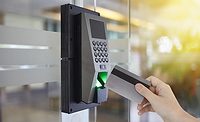Mark Brown was hearing rumors about contactless cards. The buzz around the Vanderbilt University Medical Center was that proximity cards were the next step in hospital security and data protection, but Brown wasn’t satisfied with the idea of using Prox – the Vanderbilt Card Office Manager made a move for smart cards for both the university and the hospital.
"If we were going to roll out a new system, I wanted secure technology, not something that could be approaching its end of life,” says Brown. “The HID iCLASS card system worked well with our existing ID management platform, so we could focus our energy and budget on a slow migration from magstripe student IDs to smart card badges without having to run two systems.”
The smart cards were issued to incoming university freshmen over a three-year period, after which all remaining university IDs were switched over. Students can use the cards for building access and laundry, and faculty departments can migrate over at their request, adding smart card readers to their buildings or offices as necessary. During the transition, magstripe cards could still be used, due to a modular feature on the card readers that integrates both magstripe and contactless capabilities.
"We didn’t have to switch all of our readers and cards in one go. This gave us the flexibility to upgrade over a longer period of time, and when we want to remove the magstripe capabilities, we just remove that portion of the reader without much trouble,” Brown says. “We wanted to build up our card base (on campus) before adding readers, so awareness would be up and staff would request us to replace their readers with iCLASS versions when they refurbish their offices.”
On the medical center side, the smart cards have recently been issued to all 20,000 hospital staff, and doctors can access PCs on the medical campus by using their smart card and a PIN at a console, accessing their patients’ information, and then pull up the same screens again in a patient’s room or different office by tapping their badge against a PC access point.
This slower, staged implementation of smart cards allowed Brown and the Card Services department to spread out the costs of the system over three years for the university, all while working out kinks in the system to ensure that when the hospital migrated over, it would be a smooth transition with an experienced team.
“When it comes to smart card installations, the cost of the cards is the barrier we hear cited most often,” says Randy Vanderhoof, Executive Director of the Smart Card Alliance, a non-profit association advocating smart card technology. “However, colleges have already invested in complex, campus-wide card systems that tie into pre-existing central database, using those systems for meal plans, recreational center access, library services, point of sale functions and more, in addition to building access.
“Student IDs are often managed by committee that represents all of the departments on campus,” Vanderhoof continues. “So it’s up to the security director or card services director to make the case to the whole campus for a more secure, diversifiable card system. Non-smart cards put the data for these programs in a central system, instead of containing it on the card itself. This strategy puts a lot of valuable data, possibly including financial data, in a centralized location. On a smart card, that data is often held deeper on the card itself, and the card doesn’t have the same vulnerabilities for copying or counterfeiting as other solutions.
“There are capabilities that smart cards provide that other technologies don’t offer, such as requiring a PIN number in addition to having the card, or using a biometric like a fingerprint to protect particular secure facilities like laboratories or research buildings,” he adds.
Brown had a relatively easy time getting other departments on board with smart cards, as Card Services shoulders the costs of installation and implementation. But that doesn’t mean he isn’t seeing a return on his department’s investment.
While the system is indeed better protecting patient information, enabling students to access dormitories and laundry rooms, and even presents the possibility of connecting with point of sale systems across both the university and hospital campuses, one measurable impact of swapping technologies is the reduction in maintenance.
“Just think about how many times a dormitory building door is opened every day – that’s thousands of card swipes,” Brown says. “Eventually the cards wear out, and eventually the readers break. Removing that component, making the system touchless, saves a lot of time and money on repairs and rebadging.”
In addition, students or medical personnel who lose their ID badge can instantly turn the card off using single sign-on via their smartphone, and either reactivate it when they find the card or report it missing and be issued a new badge.
Moving forward, Brown is looking to add attendance tracking to department offices, especially when meeting organizers need to record who missed an event or needs to make up training. Also, while there isn’t currently a contactless point-of-sale system on either campus, it’s something Brown is researching for future applications.
“We have around 80 cash registers between the two campuses. They’re all magstripe-enabled now, and there’s very little cash used. I could see that moving to a smart card function, just for the sheer ease of only needing the one badge,” he says.
“We’re facing one big change moving forward,” says Vanderhoof. “Some larger financial enterprises in the U.S. are adopting smart cards for credit or debit cards because of the added security. Colleges or enterprises that have proprietary banks or agreements with other banks for student credit cards or bank accounts could find significant advantages in using smart cards for both ID badges and financial access. This is likely to be a further reason for smart card implementation as part of the mainstream in the near future.”
ID Card News
“Even for me, as a citizen, I didn’t always feel safe (from deportation),” New York City Councilman Carlos Menchaca, told the Daily News. “I grew up in my family feeling like we were in the shadows.” He now says that tens of thousands of immigrant families live with the same fear.
When he was a child in El Paso, Texas, Menchaca’s single mother – a U.S. citizen – was mistakenly removed from the country several times. This is leading Menchaca (D-Brooklyn), the first Mexican-American member of the City Council, to co-sponsor controversial legislation that would create municipal ID cards –cards that would be offered to city residents regardless of their legal status, making it easier to lease apartments, open bank accounts or pick up kids from school.
Cards would be administered by the Mayor’s Office of Operations, and they would contain the cardholder’s photo, name, date of birth and address. Municipal IDs are already issued in Oakland and San Francisco; in Trenton and Princeton, New Jersey; and in New Haven, Connecticut.
Hearings for this legislation were scheduled to begin in the middle of May – what do you think about this issue? Would municipal IDs be beneficial to verify identities within your enterprise, or would they open up risk, “blatantly creating a fictitious identity for hundreds of thousands of individuals without putting in pace the proper safety protocols,” as State Sen. Greg Ball (R-Putnam) says?
Join the conversation at our LinkedIn page.
Product Showcases
Adds Convenience and Security for Smart Card Printing and Encoding
FARGO® HDP5000 High Definition Printer/Encoder by HID Global
Recent enhancements to this retransfer solution include a new graphical display, faster throughput speeds, a dual card hopper and other expanded capabilities for added convenience, security and versatility. Ideal for a wide range of customers, including large government, financial, corporate and education institutions, this printer and encoder supplies superior print quality, higher reliability and durability and greater security when issuing smart cards.
Learn more at www.hidglobal.com
Unites Disparate Physical and Logical Access Control Systems on One Card
Eligo SurePass by Tyco Integrated Security
This identity management technology creates standards-based Secure Identity badges for physical and logical access control, streamlining ease of use for employees and enhancing control and security for the enterprise. The system alleviates the need for multiple identity tokens, incorporating biometrics into the credential. The smart card will then only grant facility access for individuals through a multi-factor challenge response, and the user presents his or her corresponding biometric to a door reader for physical or logical access.
Find out more at www.tycois.com
Encodes and Laminates in One Pass, Offering Faster Throughput
Datacard SD460 Card Printer and Laminator
This two-in-one printer and laminator encodes smart chips and magnetic stripes and laminates in one pass, offering better reliability and faster throughput. It offers a new, unique, patent-pending tactile impression feature that makes cards more secure as well. “As schools face more serious security threats, photos and basic identity data are no longer enough to protect students, staff and facilities,” says Connell Smith, vice president at Datacard Group. “It’s very important for issuers to have a more sophisticated, layered approach to ID card issuance to increase security and durability in their card programs – while keeping costs low. We continue to enhance our desktop family for exactly that reason – to give issuers next-generation technologies and more efficient solutions to help prevent ID card counterfeiting and fight against fraud.”
Learn more at www.datacard.com/id






